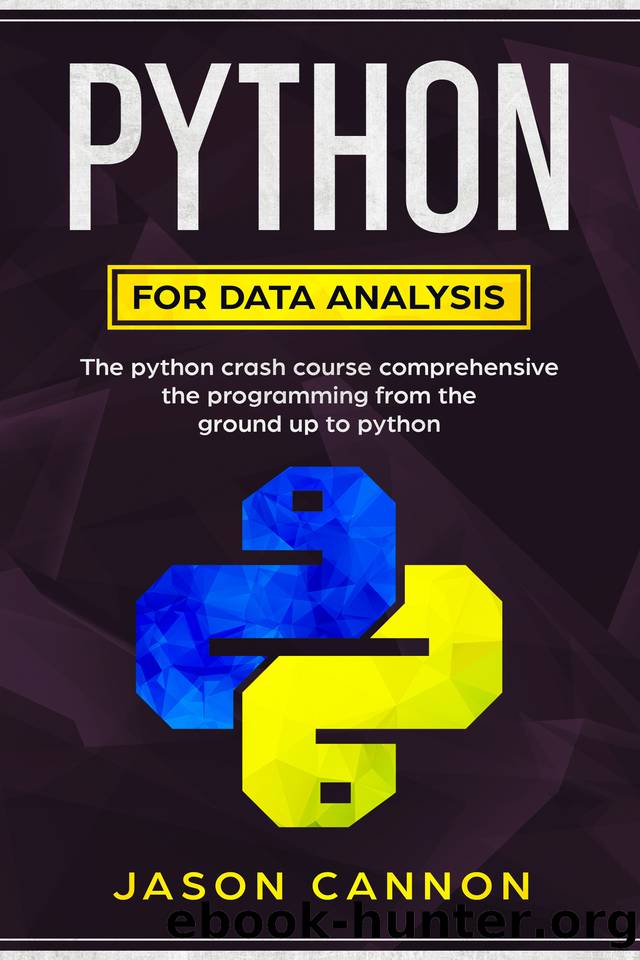python for data analysis: the python crash course comprehensive the programming from the ground up to python by cannon jason

Author:cannon, jason [cannon, jason]
Language: eng
Format: epub
Published: 2020-09-09T16:00:00+00:00
import h5py
import numpy as np
arr1 = np.random.randn(10000)
arr2 = np.random.randn(10000)
with h5py.File('complex_read.hdf5', 'w') as f:
f.create_dataset('array_1', data=arr1)
f.create_dataset('array_2', data=arr2)
We have two datasets called array_1 and array_2, each and every ha an arbitrary numpy cluster put away in it. We need to peruse the estimations of array_2 that relate to the factors where the estimations of array_1 are certain. We can attempt to accomplish something like this:
with h5py.File('complex_read.hdf5', 'r') as f:
d1 = f['array_1']
d2 = f['array_2']
information = d2[d1>0]
yet, it won't work. d1 is a dataset and cannot be contrasted with a total number. The essential route is to virtually peruse the facts from the circle and later on suppose about it. In this manner, we will wind up with some thing like this :
with h5py.File('complex_read.hdf5', 'r') as f:
d1 = f['array_1']
d2 = f['array_2']
information = d2[d1[:]>0]
The first dataset, d1 is definitely stacked into reminiscence when we do d1[:], yet we get just a few elements from the 2d dataset d2. On the off risk that the d1 dataset would have been too great to ever be stacked into memory at the identical time, we should have worked interior a circle.
with h5py.File('complex_read.hdf5', 'r') as f:
d1 = f['array_1']
d2 = f['array_2']
information = []
for I in range(len(d1)):
in the event that d1[i] > 0:
data.append(d2[i])
print('The size of statistics with a for circle: {}'.format(len(data)))
Obviously, there are effectiveness issues in regards to perusing a cluster element by element and attaching it to a rundown, yet it is a generally top notch case of likely the excellent bit of leeway of using HDF5 over content or numpy records. Inside the circle, we are stacking into reminiscence simply a single component. In our model, each and every factor is only a number, yet it may want to have been anything, from a content to a photograph or a video.
As continually, contingent upon your application, you must pick in the event that you need to peruse the total exhibit into memory or not. Some of the time you run reproductions on a unique PC with lots of memory, yet you don't have comparable determinations in your pc and you are compelled to peruse lumps of your information. Keep in mind that perusing from a hard pressure is moderately moderate, specially on the off threat that you are utilising HDD rather than SDD circles or appreciably extra on the off danger that you are perusing from a gadget drive.
Specific Writing to HDF5 Files
In the models above we have affixed data to an informational collection when this was once made. For some applications, be that as it may, you have to spare facts whilst it is being produced. HDF5 permits you to spare statistics in a basically the same as approach to how you examine it back. We ought to identify how to make a void dataset and add a few records to it.
arr = np.random.randn(100)
with h5py.File('random.hdf5', 'w') as f:
dset = f.create_dataset("default", (1000,))
dset[10:20] = arr[50:60 ]
The fundamental couple of lines are equal to previously, barring for create_dataset. We don't connect facts when making it, we absolutely make a void dataset equipped to maintain up to a thousand components.
Download
This site does not store any files on its server. We only index and link to content provided by other sites. Please contact the content providers to delete copyright contents if any and email us, we'll remove relevant links or contents immediately.
| Ada | Ajax |
| Assembly Language Programming | Borland Delphi |
| C & C++ | C# |
| CSS | Compiler Design |
| Compilers | DHTML |
| Debugging | Delphi |
| Fortran | Java |
| Lisp | Perl |
| Prolog | Python |
| RPG | Ruby |
| Swift | Visual Basic |
| XHTML | XML |
| XSL |
Hello! Python by Anthony Briggs(9373)
OCA Java SE 8 Programmer I Certification Guide by Mala Gupta(9343)
The Mikado Method by Ola Ellnestam Daniel Brolund(9307)
Algorithms of the Intelligent Web by Haralambos Marmanis;Dmitry Babenko(7852)
Sass and Compass in Action by Wynn Netherland Nathan Weizenbaum Chris Eppstein Brandon Mathis(7402)
Test-Driven iOS Development with Swift 4 by Dominik Hauser(7325)
Grails in Action by Glen Smith Peter Ledbrook(7296)
The Well-Grounded Java Developer by Benjamin J. Evans Martijn Verburg(7117)
Secrets of the JavaScript Ninja by John Resig Bear Bibeault(5957)
Kotlin in Action by Dmitry Jemerov(4638)
Hands-On Full-Stack Web Development with GraphQL and React by Sebastian Grebe(3888)
Functional Programming in JavaScript by Mantyla Dan(3723)
Learning Java by Patrick Niemeyer & Daniel Leuck(2872)
Learning React: Functional Web Development with React and Redux by Banks Alex & Porcello Eve(2839)
Mastering Python for Finance by Weiming James Ma;(2839)
Windows APT Warfare by Sheng-Hao Ma(2617)
WordPress Plugin Development Cookbook by Yannick Lefebvre(2603)
Mastering Java 9 by Dr. Edward Lavieri(2573)
Architecting Modern Java EE Applications: Designing lightweight, business-oriented enterprise applications in the age of cloud, containers, and Java EE 8 by Daschner Sebastian(2559)
